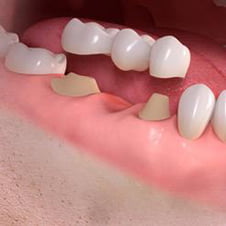- 11 Queen's Road
- Buckhurst Hill
- Essex
- IG9 5BZ
A dental bridge is a fixed solution to replace a missing tooth or to fill a gap between teeth.
There are two main types of bridges – traditional bridges and adhesive bridges.
Traditional bridge treatment involves filing down the teeth next to the gap. A bridge is then fabricated to replace the missing tooth.
A conventional bridge can be supported by one neighbouring tooth, usually the tooth behind the gap. This type of bridge is called a cantilever bridge.
A bridge can also be supported by the teeth on either side of the gap. This type of bridge is potentially a lot more invasive as it requires two teeth to be filed down to support the bridge.



No, you will be given a local anaesthetic before the procedure to block out any pain. There will also be appropriate checks to ensure that you can bite correctly with the bridge in place and that it is a comfortable fit.
An adhesive bridge is a false tooth that is attached to a metal wing that is glued to the inside and biting surface of the neighbouring tooth.


A mould of your teeth and gums is created. This is so that the bridge can be custom-made to your individual requirements. Adhesive bridges often require no or very minimal drilling. The procedure to prepare an adhesive bridge is carried out without injections in most cases.
The impressions or moulds of your teeth are sent to a specialist dental laboratory where the bridge is made. When the bridge is made and returned from the laboratory it is cemented in place and is often carried out without the need for an injection.
Research indicates that 88% of adhesive bridges survive five years or more and 65% survive ten years or more.